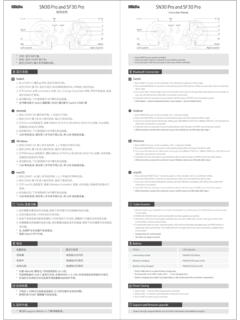Transcription of Understanding Risk-Aversion through Utility Theory
1 Understanding Risk-Aversion through Utility TheoryAshwin RaoICME, Stanford UniversityFebruary 3, 2020 Ashwin Rao (Stanford) Utility TheoryFebruary 3, 20201 / 14 Intuition on Risk-Aversion and Risk-PremiumLet s play a game where your payoff is based on outcome of a fair coinYou get $100 for HEAD and $0 for TAILHow much would you pay to play this game?You immediately say: Of course, $50 Then you think a bit, and say: A little less than $50 Less because you want to be compensated for taking the risk The wordRiskrefers to the degree of variation of the outcomeWe call this risk-compensation asRisk-PremiumOurpersonality-baseddegree of risk fear is known asRisk-AversionSo, we end up paying $50 minus Risk-Premium to play the gameRisk-Premium grows with Outcome-Variance & Risk-AversionAshwin Rao (Stanford) Utility TheoryFebruary 3, 20202 / 14 Specifying Risk-Aversion through a Utility functionWe seek a valuation formula for the amount we d pay that.
2 Increases one-to-one with the Mean of the outcomeDecreases as the Variance of the outcome ( Risk) increasesDecreases as our Personal Risk-Aversion increasesThe last two properties above define the Risk-PremiumBut fundamentally why are we Risk-Averse?Why don t we just pay the mean of the random outcome?Reason: Our satisfaction to better outcomes grows non-linearlyWe express this satisfaction non-linearity as a mathematical functionBased on a core economic concept calledUtility of ConsumptionWe will illustrate this concept with a real-life exampleAshwin Rao (Stanford) Utility TheoryFebruary 3, 20203 / 14 Law of Diminishing Marginal UtilityAshwin Rao (Stanford)
3 Utility TheoryFebruary 3, 20204 / 14 Utility of Consumption and Certainty-Equivalent ValueMarginal Satisfaction of eating cookies is a diminishing functionHence, Accumulated Satisfaction is a concave functionAccumulated Satisfaction represents Utility of ConsumptionU(x)Wherexrepresents the uncertain outcome being consumedDegree of concavity represents extent of our Risk-AversionConcaveU( ) function E[U(x)]<U(E[x])We defineCertainty-Equivalent ValuexCE=U 1(E[U(x)])Denotes certain amount we d pay to consume an uncertain outcomeAbsolute Risk-Premium A=E[x] xCERelative Risk-Premium R= AE[x]=E[x] xCEE[x]= 1 xCEE[x]Ashwin Rao (Stanford) Utility TheoryFebruary 3, 20205 / 14 Certainty-Equivalent ValueAshwin Rao (Stanford) Utility TheoryFebruary 3, 20206 / 14 Calculating the Risk-PremiumWe develop mathematical formalism to calculate Risk-Premia A, RTo lighten notation, we refer toE[x] as xand Variance ofxas 2xTaylor-expandU(x) around x, ignoring terms beyond quadraticU(x) U( x) +U ( x) (x x) +12U ( x) (x x)2 Taylor-expandU(xCE)
4 Around x, ignoring terms beyond linearU(xCE) U( x) +U ( x) (xCE x)Taking the expectation of theU(x) expansion, we get:E[U(x)] U( x) +12 U ( x) 2xSinceE[U(x)] =U(xCE), the above two expressions are . Hence,U ( x) (xCE x) 12 U ( x) 2xAshwin Rao (Stanford) Utility TheoryFebruary 3, 20207 / 14 Absolute & Relative Risk-AversionFrom the last equation on the previous slide, Absolute Risk-Premium A= x xCE 12 U ( x)U ( x) 2xWe refer to function A(x) = U (x)U (x)as theAbsolute Risk-Aversion A 12 A( x) 2xIn multiplicative uncertainty settings, we focus on variance 2x xofx xIn multiplicative settings, we also focus on Relative Risk-Premium R R= A x 12 U ( x) xU ( x) 2x x2= 12 U ( x) xU ( x) 2x xWe refer to function R(x) = U (x) xU (x)
5 As theRelative Risk-Aversion R 12 R( x) 2x xAshwin Rao (Stanford) Utility TheoryFebruary 3, 20208 / 14 Taking stock of what we re learning hereWe ve shown that Risk-Premium can be expressed as the product of:Extent of Risk-Aversion : eitherA( x) orR( x)Extent of uncertainty of outcome: either 2xor 2x xWe ve expressed the extent of Risk-Aversion as the ratio of:Concavity of the Utility function (at x): U ( x)Slope of the Utility function (at x):U ( x)For optimization problems, we ought to maximizeE[U(x)] (notE[x])Linear Utility functionU(x) =a+b ximpliesRisk-NeutralityNow we look at typically-used Utility functionsU( ) with.
6 Constant Absolute Risk-Aversion (CARA)Constant Relative Risk-Aversion (CRRA)Ashwin Rao (Stanford) Utility TheoryFebruary 3, 20209 / 14 Constant Absolute Risk-Aversion (CARA)Consider the Utility functionU(x) =1 e axafora6= 0 Absolute Risk-AversionA(x) = U (x)U (x)=aais called Coefficient of Constant Absolute Risk-Aversion (CARA)Fora= 0,U(x) =x(meaning Risk-Neutral)If the random outcomex N( , 2),E[U(x)] = 1 e a +a2 22afora6= 0 fora= 0xCE= a 22 Absolute Risk Premium A= xCE=a 22 For optimization problems where 2is a function of , we seek thedistribution that maximizes a 22 Ashwin Rao (Stanford) Utility TheoryFebruary 3, 202010 / 14A Portfolio Application of CARAWe are given $1 to invest and hold for a horizon of 1 yearInvestment choices are 1 risky asset and 1 riskless assetRisky Asset Annual Return N( , 2)Riskless Asset Annual Return =rDetermine unconstrained to allocate to risky asset (1 to riskless)Such that Portfolio has maximum Utility of Wealth in 1 yearWith CARA UtilityU(W)
7 =1 e aWafora6= 0 Portfolio WealthW N(1 +r+ ( r), 2 2)From the section on CARA Utility , we know we need to maximize:1 +r+ ( r) a 2 22So optimal investment fraction in risky asset = ra 2 Ashwin Rao (Stanford) Utility TheoryFebruary 3, 202011 / 14 Constant Relative Risk-Aversion (CRRA)Consider the Utility functionU(x) =x1 11 for 6= 1 Relative Risk-AversionR(x) = U (x) xU (x)= is called Coefficient of Constant Relative Risk-Aversion (CRRA)For = 1,U(x) = log(x). For = 0,U(x) =x 1 (Risk-Neutral)If the random outcomexis lognormal, with log(x) N( , 2),E[U(x)] = e (1 )+ 22(1 )2 11 for 6= 1 for = 1xCE=e + 22(1 )Relative Risk Premium R= 1 xCE x= 1 e 2 2 For optimization problems where 2is a function of , we seek thedistribution that maximizes + 22(1 )Ashwin Rao (Stanford) Utility TheoryFebruary 3, 202012 / 14A Portfolio Application of CRRA (Merton 1969)We work in the setting of Merton s 1969 Portfolio problemWe only consider the single-period (static) problem with 1 risky assetRiskless asset:dRt=r Rt dtRisky asset.
8 DSt= St dt+ St dzt( Geometric Brownian)We are given $1 to invest, with continuous rebalancing for 1 yearDetermine constant fraction ofWtto allocate to risky assetTo maximize Expected Utility of WealthW=W1(at timet= 1)Constraint: Portfolio is continuously rebalanced to maintain fraction So, the process for wealthWtis given by:dWt= (r+ ( r)) Wt dt+ Wt dztAssume CRRA UtilityU(W) =W1 11 ,0< 6= 1 Ashwin Rao (Stanford) Utility TheoryFebruary 3, 202013 / 14 Recovering Merton s solution (for this static case)Applying Ito s Lemma on logWtgives us:logWt= t0(r+ ( r) 2 22) du+ t0 dzu logW N(r+ ( r) 2 22, 2 2)From the section on CRRA Utility , we know we need to maximize:r+ ( r) 2 22+ 2 2(1 )2=r+ ( r) 2 2 2So optimal investment fraction in risky asset = r 2 Ashwin Rao (Stanford) Utility TheoryFebruary 3, 202014 / 14













